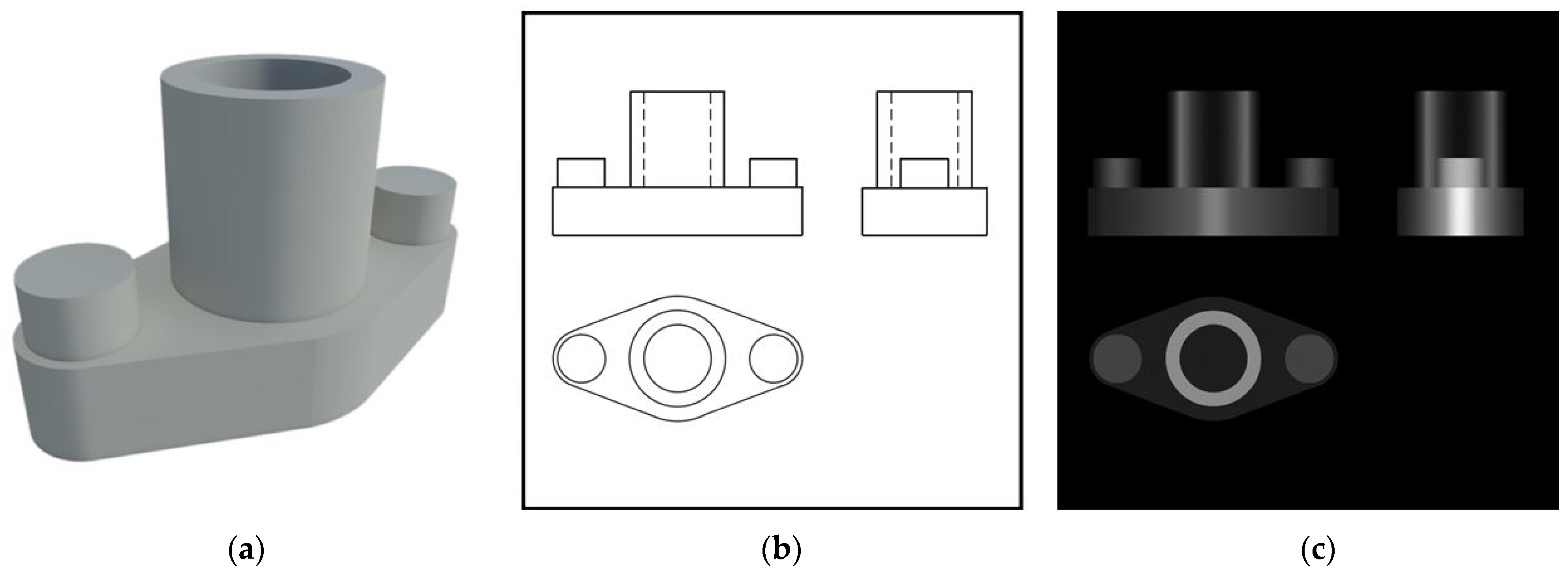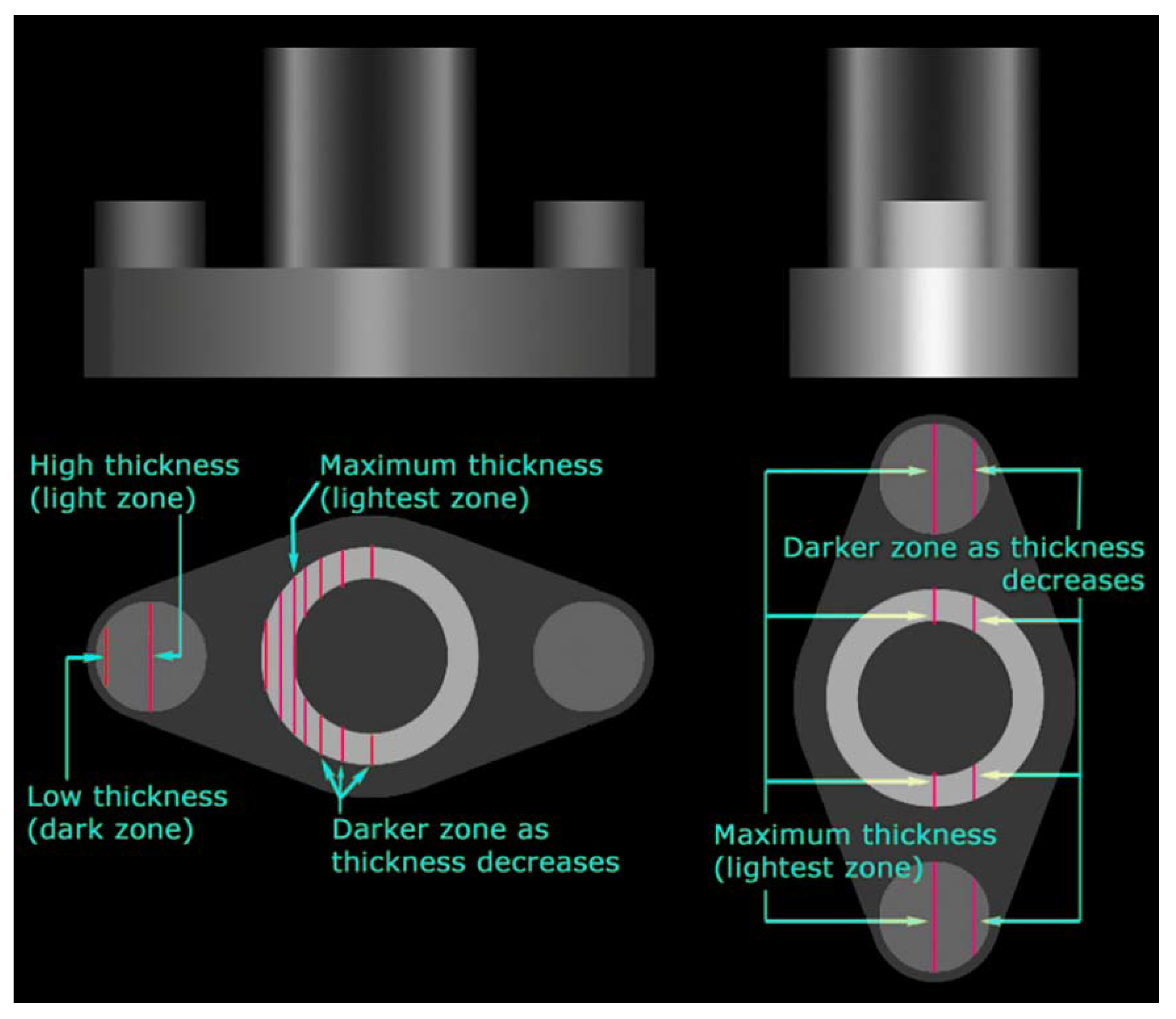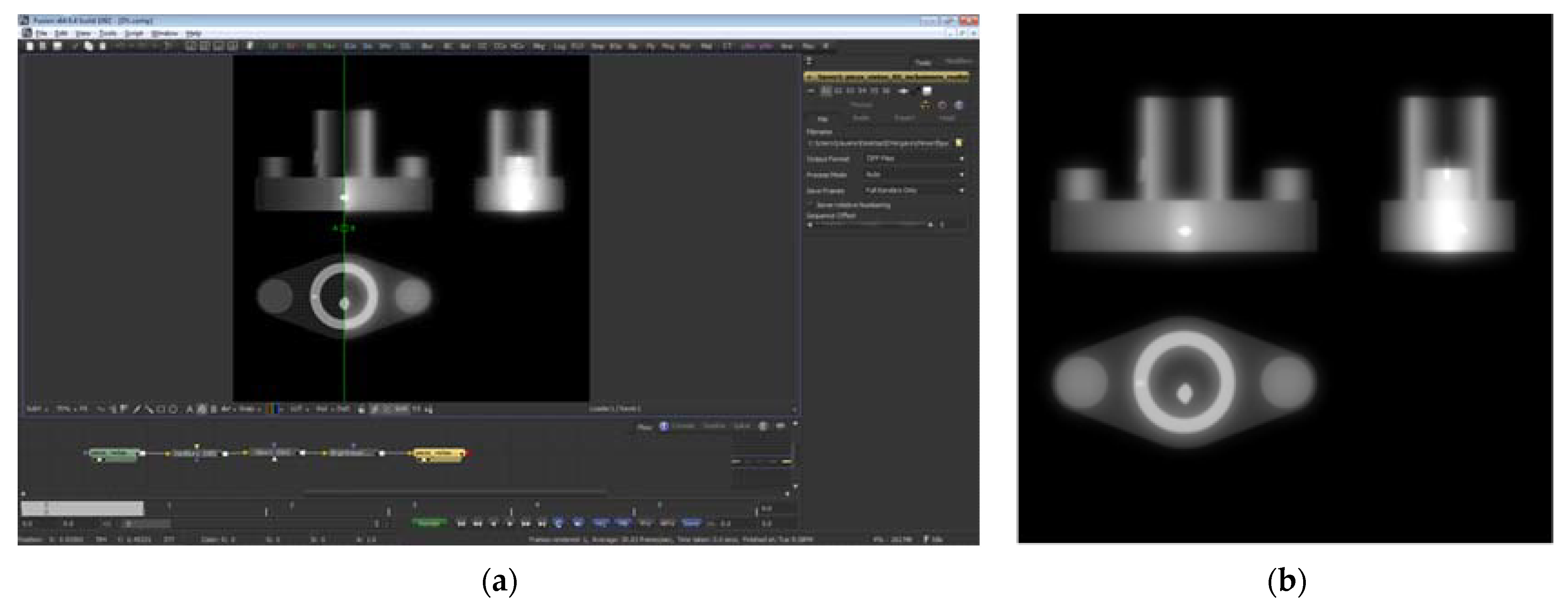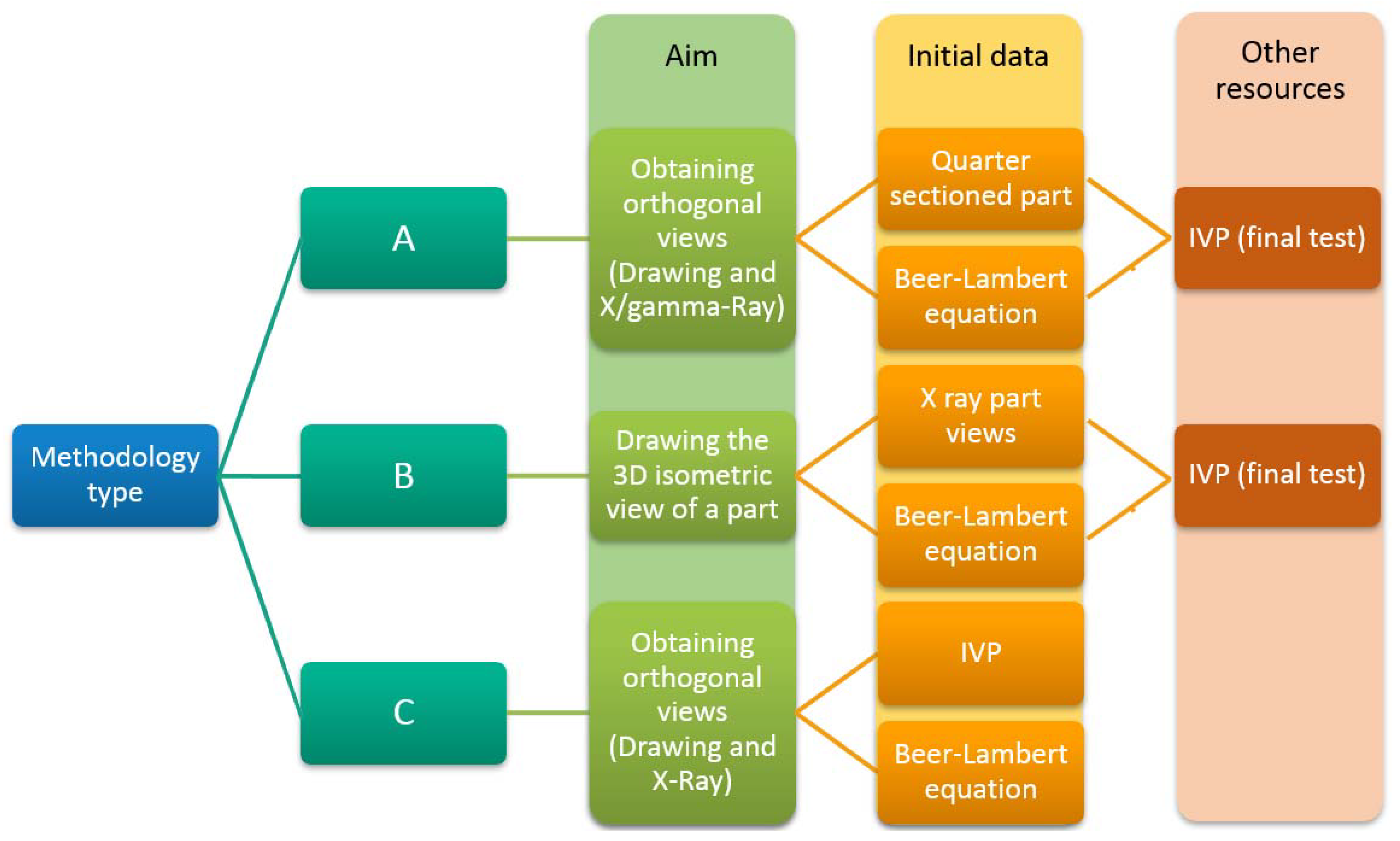Interdisciplinary Learning Methodology for Supporting the Teaching of Industrial Radiology through Technical Drawing
Abstract
:1. Introduction
2. Theoretical Background of Industrial Radiology
3. Interdisciplinary Learning
4. Interactive Virtual Platform
5. Creation of Didactic Material
6. Classroom Implementation
- Methodology type C: students use the IVP by interacting with the 3D model of the part (Figure 5) to subsequently represent the orthogonal views of the part. Since the IVP allows interaction with the parts, the use of the IVP enables students to reinforce their spatial vision skills in a self-directed manner.
- Mentally visualize complex three-dimensional geometries in space.
- Recognize figures isolated from the context in which they are found.
- Recognize that an object maintains its shape even if it is no longer visible in whole or in part.
- Relate the position of a three-dimensional object with respect to an observer or other object used as a reference point.
- Identify the relationships between different objects placed in space.
- Compare different three-dimensional objects by visually analyzing their similarities and differences.
- Recall and mentally recreate visual characteristics, as well as the position they occupied in space, of a set of objects.
7. Described ICT-Based Didactic Tools and 2030 Agenda
8. Conclusions
Author Contributions
Funding
Conflicts of Interest
References
- Sierra, E.; Garmendia, M.; Barrenetxea, L. Solving the Problem of Interpreting Views: Teaching the Part Visualization Process. Int. J. Eng. Educ. 2012, 28, 663–673. [Google Scholar]
- Makgato, M.; Khoza, S.D. Difficulties of student teachers in the engineering Graphics and Design course at a South African university: Snapshot on sectional drawing. Eurasia J. Math. Sci. Technol. Educ. 2016, 12, 703–715. [Google Scholar] [CrossRef]
- Vergara, D.; Rubio, M.P. Active methodologies through interdisciplinary teaching links: Industrial radiography and technical drawing. J. Mater. Educ. 2012, 34, 175–185. [Google Scholar]
- Contreras, M.J.; Escrig, R.; Prieto, G.; Elosua, M.R. Spatial visualization ability improves with and without studying technical drawing. Cogn. Process. 2018, 19, 387–397. [Google Scholar] [CrossRef]
- Mendez, M.; Martin, S.; Arias, N.; Rubio, R.; Arias, J.L. Assessment of visual and memory components of spatial ability in engineering students who have studied technical drawing. Int. J. Eng. Educ. 2014, 30, 806–812. [Google Scholar]
- Ogunkola, B.; Knight, C. Does technical drawing increase students’ mental rotation ability? Cogent Educ. 2018, 5, 1–9. [Google Scholar] [CrossRef]
- Ogunkola, B.; Knight, C. Technical drawing course, video games, gender, and type of school on spatial ability. J. Educ. Res. 2019, 112, 575–589. [Google Scholar] [CrossRef]
- Levy, D. How Dynamic Visualization Technology can Support Molecular Reasoning. J. Sci. Educ. Technol. 2013, 22, 702–717. [Google Scholar] [CrossRef]
- Fogarty, J.; McCormick, J.; El-Tawil, S. Improving student understanding of complex spatial arrangements with virtual reality. J. Prof. Issues Eng. Educ. Pract. 2018, 144, 04017013. [Google Scholar] [CrossRef]
- Jamil, Z.; Saeed, A.A.; Madhani, S.; Baig, S.; Cheema, Z.; Fatima, S.S. Three-dimensional visualization software assists learning in students with diverse spatial intelligence in medical education. Anat. Sci. Educ. 2019, 12, 550–560. [Google Scholar] [CrossRef]
- Pei, X.; Jin, Y.; Zheng, T.; Zhao, J. Longitudinal effect of a technology-enhanced learning environment on sixth-grade students’ science learning: The role of reflection. Int. J. Sci. Educ. 2020, 42, 271–289. [Google Scholar] [CrossRef]
- Vergara, D.; Extremera, J.; Rubio, M.P.; Dávila, L.P. Meaningful learning through virtual reality learning environments: A case study in materials engineering. Appl. Sci. 2019, 9, 4625. [Google Scholar] [CrossRef] [Green Version]
- Extremera, J.; Vergara, D.; Rubio, M.P.; Dávila, L.P.; de la Prieta, F. Effects of time in virtual reality learning environments linked with materials science and engineering. In Advances in Intelligent Systems and Computing, Proceedings of the Methodologies and Intelligent Systems for Technology Enhanced Learning, 10th International Conference MIS4TEL 2020, L’Aquila, Italy, 17–19 June 2020; Vittorini, P., Di Mascio, T., Tarantino, L., Temperini, M., Gennari, R., de la Prieta, F., Eds.; Springer: Cham, Switzerland, 2020; Volume 1241. [Google Scholar]
- Chen, Y.C.; Chi, H.L.; Hung, W.H.; Kang, S.C. Use of tangible and augmented reality models in engineering graphics courses. J. Prof. Issues Eng. Educ. Pract. 2011, 137, 267–276. [Google Scholar] [CrossRef]
- Vergara, D.; Rubio, M.P.; Lorenzo, M. A virtual environment for enhancing the understanding of ternary phase diagrams. J. Mater. Educ. 2015, 37, 93–101. [Google Scholar]
- Vergara, D.; Rubio, M.P.; Lorenzo, M. A virtual resource for enhancing the spatial comprehension of crystal lattices. Educ. Sci. 2018, 8, 153. [Google Scholar] [CrossRef] [Green Version]
- Extremera, J.; Vergara, D.; Dávila, L.P.; Rubio, M.P. Virtual and augmented reality environments to learn the fundamentals of crystallography. Crystals 2020, 10, 456. [Google Scholar] [CrossRef]
- Melgosa, C.; Ramos, B.; Roman, A. Spatial visualization learning in engineering: Traditional methods vs. a web-based tool. Educ. Technol. Soc. 2014, 17, 142–157. [Google Scholar]
- Vergara, D.; Rubio, M.P.; Lorenzo, M. On the use of PDF-3D to overcome spatial visualization difficulties linked with ternary phase diagrams. Educ. Sci. 2019, 9, 67. [Google Scholar] [CrossRef] [Green Version]
- Murad, S.; Passero, I.; Francese, R.; Tortora, G. An empirical evaluation of technical drawing didactic in virtual worlds. Int. J. Online Eng. 2011, 7, 23–30. [Google Scholar] [CrossRef] [Green Version]
- Pando, P.; Suárez, J.M.; Busto, B.; Rodríguez, D.; Álvarez, P.I. Can interactive web-based CAD tools improve the learning of engineering drawing? A case study. J. Sci. Educ. Technol. 2014, 23, 398–411. [Google Scholar] [CrossRef]
- Baronio, G.; Motyl, B.; Paderno, D. Technical Drawing Learning Tool-Level 2: An interactive self-learning tool for teaching manufacturing dimensioning. Comput. Appl. Eng. Educ. 2016, 24, 519–528. [Google Scholar] [CrossRef]
- Speranza, D.; Baronio, G.; Motyl, B.; Filippi, S.; Villa, V. Best practices in teaching technical drawing: Experiences of collaboration in three Italian universities. In Lecture Notes in Mechanical Engineering, Advances on Mechanics, International Joint Conference on Mechanics, Design Engineering and Advanced Manufacturing JCM 2017; Eynard, B., Nigrelli, V., Oliveri, S., Peris-Fajarnes, G., Rizzuti, S., Eds.; Springer: Cham, Switzerland, 2016; pp. 905–914. [Google Scholar]
- Mansilla, V.B.; Duraising, E.D. Targeted assessment of students’ interdisciplinary work: An empirically grounded framework proposed. J. High. Educ. 2007, 78, 215–237. [Google Scholar] [CrossRef]
- Spelt, E.J.H.; Biemans, H.J.A.; Tobi, H.; Luning, P.A.; Mulder, M. Teaching and learning in interdisciplinary higher education: A systematic review. Educ. Psychol. Rev. 2009, 21, 365–378. [Google Scholar] [CrossRef] [Green Version]
- Van Merriënboer, J.J.G. Training Complex Cognitive Skills: A Four-Component Instructional Design Model for Technical Training; Educational Technology: Englewood Cliffs, NJ, USA, 1997. [Google Scholar]
- White, D.; Delaney, S. Full STEAM ahead, but who has the map for integration?—A PRISMA systematic review on the incorporation of interdisciplinary learning into schools. Lumat 2021, 9, 9–32. [Google Scholar] [CrossRef]
- Borrego, M.E.; Rhyne, R.; Hansbarger, L.C.; Geller, Z.; Edwards, P.; Griffin, B.; McClain, L.; Scaletti, J. V Pharmacy student participation in rural interdisciplinary education using problem based learning (PBL) case tutorials. Am. J. Pharm. Educ. 2000, 64, 355–363. [Google Scholar]
- Harrison, G.P.; Macpherson, D.E.; Williams, D.A. Promoting interdisciplinarity in engineering teaching. Eur. J. Eng. Educ. 2007, 32, 285–293. [Google Scholar] [CrossRef] [Green Version]
- Furlan, P.Y.; Kitson, H.; Andes, C. Chemistry, poetry, and artistic illustration: An interdisciplinary approach to teaching and promoting chemistry. J. Chem. Educ. 2007, 84, 1625–1630. [Google Scholar] [CrossRef]
- Mhamed, I.B.; Abid, S.; Fnaiech, F. Weld defect detection using a modified anisotropic diffusion model. J. Adv. Signal. Process. 2012, 2012, 46. [Google Scholar] [CrossRef] [Green Version]
- Nilsson, T.; Hedman, L.; Ahlqvist, J. Visual-spatial ability and interpretation of three-dimensional information in radiographs. Dentomaxillofac. Radiol. 2007, 36, 86–91. [Google Scholar] [CrossRef]
- Ramírez-Arias, J.L.; Rodriguez-Treviño, C.; González-Vergara, C. The challenge of radiology education in developing countries. Biomed. Imaging Interv. J. 2008, 4, e2. [Google Scholar] [CrossRef] [PubMed] [Green Version]
- Scarsbrook, A.F.; Graham, R.N.J.; Perriss, R.W. Radiology education: A glimpse into the future. Clin. Radiol. 2006, 61, 640–648. [Google Scholar] [CrossRef] [PubMed]
- Felisberto, M.K.; Centeno, T.M.; Arruda, L.V.R.; Lopes, H.S. Automatic analysis of radiographic images for non destructive test applications. In Proceedings of the 10th SEM International Congress on Experimental and Applied Mechanics, Costa Mesa, CA, USA, 7–10 June 2004. [Google Scholar]
- Nacereddine, N.; Zelmat, M.; Belaïfa, S.S.; Tridi, M. Weld defect detection in industrial radiography based digital image processing. In Proceedings of the Conference of the World Academy of Science Engineering and Technology, Berlin, Germany, 19–21 January 2005; Ardil, C., Ed.; World Academy of Science, Engineering and Technology: Canakkale, Turkey, 2005; Volume 2, pp. 112–115. [Google Scholar]
- Nacereddine, N.; Tridi, M. Computer-aided shape analysis and classification of weld defects in industrial radiography based invariant attributes and neural networks. In Proceedings of the 4th International Symposium on Image and Signal Processing and Analysis (ISPA 2005), Zagreb, Croatia, 15–17 September 2005; Loncaric, S., Babic, H., Bellanger, M., Eds.; IEEE: New York, NY, USA, 2005; pp. 88–93. [Google Scholar]
- Rodríguez-Martín, M.; Rodríguez-Gonzálvez, P. Learning methodology based on weld virtual models in the mechanical engineering classroom. Comput. Appl. Eng. Educ. 2019, 27, 1113–1125. [Google Scholar] [CrossRef]
- Rodríguez-Martín, M.; Rodríguez-Gonzálvez, P. 3D Learning materials from reverse engineering for weld inspection training. Dyna 2019, 94, 238–239. [Google Scholar] [CrossRef]
- Forsyth, D.S. Nondestructive testing of corrosion in the aerospace industry. In Corrosion Control in the Aerospace Industry; Benavides, S., Ed.; Woodhead Publishing: Cambridge, UK, 2009; pp. 111–130. [Google Scholar]
- Khorshidi, A.; Khosrowpour, B.; Hosseini, S.H. Determination of defect depth in industrial radiography imaging using MCNP code and SuperMC software. Nucl. Eng. Technol. 2020, 52, 1597–1601. [Google Scholar] [CrossRef]
- Economides, S.; Tritakis, P.; Papadomarkaki, E.; Carinou, E.; Hourdakis, C.; Kamenopoulou, V.; Dimitriou, P. Occupational exposure in Greek industrial radiography laboratories (1996–2003). Radiat. Prot. Dosim. 2006, 118, 260–264. [Google Scholar] [CrossRef] [PubMed]
- Vergara, D.; Rubio, M.P.; Lorenzo, M. On the design of virtual reality learning environments in engineering. Multimodal Technol. Interact. 2017, 1, 11. [Google Scholar] [CrossRef] [Green Version]
- Vergara, D.; Extremera, J.; Rubio Cavero, M.P.; Dávila, L.P. The technological obsolescence of virtual reality learning environments. Appl. Sci. 2020, 10, 915. [Google Scholar] [CrossRef] [Green Version]
- Peters, M.; Chisolm, P.; Laeng, B. Spatial ability, student gender, and academic performance. J. Eng. Educ. 1995, 84, 69–73. [Google Scholar] [CrossRef]
- Molina-Carmona, R.; Pertegal-Felices, M.L.; Jimeno-Morenilla, A.; Mora-Mora, H. virtual reality learning activities for multimedia students to enhance spatial ability. Sustainability 2018, 10, 1074. [Google Scholar] [CrossRef] [Green Version]
- United Nations, Department of Economic and Social Affairs, Sustainable Development. Available online: https://sdgs.un.org/ (accessed on 10 April 2021).
- United Nations Educational, Scientific and Cultural Organization. Available online: https://en.unesco.org/themes/ict-education (accessed on 10 May 2021).
- Vergara, D.; Rubio, M.P.; Lorenzo, M. New approach for the teaching of concrete compression tests in large groups of engineering students. J. Prof. Issues Eng. Educ. Pract. 2017, 143, 05016009. [Google Scholar] [CrossRef]
- Kim, B.; Park, M.J. Effect of personal factors to use ICTs on e-learning adoption: Comparison between learner and instructor in developing countries. Inf. Technol. Dev. 2018, 24, 706–732. [Google Scholar] [CrossRef]








| Methodology 1 | Students without Errors in the Resolution (%) | Remarks | ||
|---|---|---|---|---|
| A | A1 | 96% | Errors in the spatial visualization of parts | |
| A2 | 92% | Errors in the spatial visualization of parts Defect spatial positioning errors | ||
| B | B1 | 1st stage | 92% | Difficulty in spatial comprehension of the complete part |
| 2nd stage | 84% | Difficulty in spatial comprehension of the complete part Defect spatial positioning errors | ||
| B2 | 1st stage | 88% | Difficulty in spatial comprehension of the complete part | |
| 2nd stage | 80% | Difficulty in spatial comprehension of the complete part Defect spatial positioning errors Students need more time to solve the exercises | ||
| C | 100% | Students emphasize the usefulness of the IVP to improve spatial comprehension of the parts | ||
| SDG | Associated Targets |
|---|---|
| SDG 4 Ensure inclusive and equitable quality education and promote lifelong learning opportunities for all. | Target 4.3 Ensure equal access for all women and men to affordable and quality technical, vocational and tertiary education, including university. |
| Target 4.4 Substantially increase the number of youth and adults who have relevant skills, including technical and vocational skills, for employment, decent jobs and entrepreneurship. | |
| Target 4.c Substantially increase the supply of qualified teachers, including through international cooperation for teacher training in developing countries, especially least developed countries and small island developing States. | |
| SDG 8 Promote sustained, inclusive and sustainable economic growth, full and productive employment and decent work for all. | Target 8.3 Promote development-oriented policies that support productive activities, decent job creation, entrepreneurship, creativity and innovation, and encourage the formalization and growth of micro-, small- and medium-sized enterprises, including through access to financial services. |
| Target 8.6 Substantially reduce the proportion of youth not in employment, education or training. | |
| Target 8.b Develop and operationalize a global strategy for youth employment and implement the Global Jobs Pact of the International Labour Organization. | |
| SDG 12 Ensure sustainable consumption and production patterns. | Target 12.1 Implement the 10-year framework of programmes on sustainable consumption and production, all countries taking action, with developed countries taking the lead, taking into account the development and capabilities of developing countries. |
| Target 12.2 Achieve the sustainable management and efficient use of natural resources. | |
| Target 12.5 Substantially reduce waste generation through prevention, reduction, recycling and reuse. |
Publisher’s Note: MDPI stays neutral with regard to jurisdictional claims in published maps and institutional affiliations. |
© 2021 by the authors. Licensee MDPI, Basel, Switzerland. This article is an open access article distributed under the terms and conditions of the Creative Commons Attribution (CC BY) license (https://creativecommons.org/licenses/by/4.0/).
Share and Cite
Vergara, D.; Rubio, M.P.; Extremera, J.; Lorenzo, M. Interdisciplinary Learning Methodology for Supporting the Teaching of Industrial Radiology through Technical Drawing. Appl. Sci. 2021, 11, 5634. https://doi.org/10.3390/app11125634
Vergara D, Rubio MP, Extremera J, Lorenzo M. Interdisciplinary Learning Methodology for Supporting the Teaching of Industrial Radiology through Technical Drawing. Applied Sciences. 2021; 11(12):5634. https://doi.org/10.3390/app11125634
Chicago/Turabian StyleVergara, Diego, Manuel P. Rubio, Jamil Extremera, and Miguel Lorenzo. 2021. "Interdisciplinary Learning Methodology for Supporting the Teaching of Industrial Radiology through Technical Drawing" Applied Sciences 11, no. 12: 5634. https://doi.org/10.3390/app11125634







